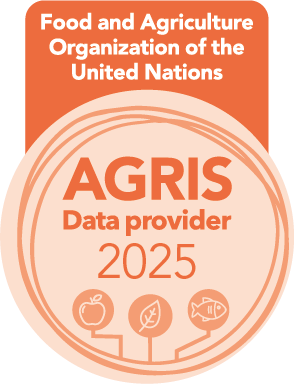

Address: Naberezhnaya Severnoy Dviny, 17, Arkhangelsk, 163002, Russian Federation, Northern (Arctic) Federal University named after M.V.Lomonosov, office 1425
Phone: +7 (8182) 21-61-18
E-mail: forest@narfu.ru
http://lesnoizhurnal.ru/en/
|
Thermal Decomposition of Pellets from a Mixture of Peat and Bark Waste. 145-154
|
 |
Terekhin A.P., Maryandyshev P.A., Golovanova I.I., Gromov A.A.
UDС
662.76
DOI:
10.37482/0536-1036-2025-3-145-154
Abstract
There are large peat deposits in the Arkhangelsk Region. According to the balance sheet data, there are 626 deposits, each of which has an area exceeding 10 ha. At the same time, the Arkhangelsk Region faces the problem of efficient energy utilization of secondary energy resources, such as wood waste and bark, generated at timber industry enterprises. Thermal analysis of pellets from a mixture of peat (80 %) and bark waste from pulp and paper production (20 %) has been performed on a synchronous thermal analyzer in an argon and air environment in the temperature range of 30–700 °С. Peat has been collected in the Mezensky District of the Arkhangelsk Region, and samples of bark waste have been collected from the bark feed line to the E-75-3.9-440 DFT and KM75-40M fluidized bed boiler units installed at TPP-3 of Arkhangelsk Pulp and Paper Mill. The pellets have been obtained in a pellet-press. The elemental composition of pellets has been studied using a spectrometer. The main ash- and slag-forming elements in the samples are silicon, aluminum, calcium and iron. The thermal analysis of pellets has been carried out on a synchronous thermal analyzer in an argon and air medium with a flow rate of 20 cm3/min. To observe the drying and thermal transformations of pellets, the curves of the decrease in mass and speed of this process in the studied samples of fuel pellets have been used. It has been shown that the release of volatile substances has occurred at temperatures from 170 to 430 °C. The resulting pellets are high-calorie and low-ash biofuel. The results of the research can be applied for theoretical substantiation of the production of fuels with high combustion heat and mechanical strength in order to increase the role of local biomass in the energy sector of the Arkhangelsk Region.
Keywordspeat fuel, bark waste, pellets, granulator, thermal analysis, thermograms, X-ray fluorescence analysis, lignin, cellulose, hemicellulose
For citation
Terekhin A.P., Maryandyshev P.A., Golovanova I.I., Gromov A.A. Thermal Decomposition of Pellets from a Mixture of Peat and Bark Waste. Lesnoy Zhurnal = Russian Forestry Journal, 2025, no. 3, pp. 145–154. (In Russ.). https://doi.org/10.37482/0536-1036-2025-3-145-154
References
- Belikova S.S., Belikov A.V. East and West: Global Challenges to Achieving Carbon Neutrality. Upravlenie = Management (Russia), 2022, vol. 10, no. 2, pp. 5–13. (In Russ.). https://doi.org/10.26425/2309-3633-2022-10-2-5-13
- Bobylev S.N., Baraboshkina A.V., Zhu Xuan. Priorities of Low-Carbon Development for China. Gosudarstvennoe upravlenie. Elektronnyj vestnik = Public Administration. E-journal, 2020, no. 82, pp. 114–139. (In Russ.). https://doi.org/10.24411/20701381-2020-10095
- Boyarkina A.V. Ecological Dimension in China’s Foreign Policy Strategy. Vestnik Rossijskogo universiteta druzhby narodov. Seriya: Mezhdunarodnye otnosheniya = Vestnik RUDN. International Relations, 2021, vol. 21, no. 2, pp. 325–337. (In Russ.). https://doi.org/10.22363/2313-0660-2021-21-2-325-337
- Bushuev V., Zaichenko V., Chernyavsky A., Shevchenko A. Energy Transition: Development Prospects. Energeticheskaya politika = Energy Policy, 2024, no. 2 (193), pp. 68–83. (In Russ.). https://doi.org/10.46920/2409-5516-2024-2193-68
- Veselova D.N. Climate Policy of the Russian Federation: Legislative and Institutional Aspects. DiskursPi = Discource P, 2021, vol. 18, no. 3, pp. 96–111. (In Russ.). https://doi.org/10.17506/18179568_2021_18_3_96
- Galimzyanova A.K. Climate Diplomacy of China and Germany.Vostochnyj al’manakh: Collection of Scientific Articles, iss. V. Moscow, Kvant Media Ltd., 2021, pp. 14–29. (In Russ.).
- Dubodelova E.V., Sycheva N.A., Khmyzov I.A., Snopkova T.A., Solov’eva T.V. Features of the Technology of Fuel Pellets from Hardwood. Trudy BGTU. Khimiya, tekhnologiya organicheskikh veshchestv i biotekhnologiya = Proceedings of BSTU. Chemistry, Organic Substances Technology and Biotechnology, 2012, no. 4, pp. 166–168. (In Russ.).
- Zotova E.V., Safonov A.O., Platonov A.D. Analytical Study of the Parameters Determining the Technology of Wood Pellet Production. Lesotekhnicheskij zhurnal = Forestry Engineering Journal, 2014, no. 1 (13), pp. 127–132. (In Russ.). https://doi.org/10.12737/3355
- Kaveshnikov N.Y. European Union’s Climate and Energy Strategy. Sovremennaya Evropa = Contemporary Europe, 2015, no. 1 (61), pp. 93–103. (In Russ.). http://dx.doi.org/10.15211/soveurope1201593103
- Kovalev Yu.Yu., Porshneva O.S. BRICS Countries in International Climate Policy. Vestnik Rossijskogo universiteta druzhby narodov. Seriya: Mezhdunarodnye otnosheniya = Vestnik RUDN. International Relations, 2021, vol. 21, no. 1, pp. 64–78. (In Russ.). https://doi.org/10.22363/2313-0660-2021-21-1-64-78
- Ryabov G.A., Litun D.S. Agglomeration during Сombustion and Gasification of Fuels in a Fluidized Bed. Teploenergetika, 2019, no. 9, pp. 42–59. (In Russ.). https://doi.org/10.1134/S0040363621010173
- Sychova N.A., Hmyzov I.A., Soloueva T.V. The Influence of Granulation and Pellets Composition on Their Strength Properties. Lesnoy vestnik = Forestry Bulletin, 2016, vol. 20, no. 3, pp. 72–79. (In Russ.).
- Aniza R., Chen W.-H., Kwon E.E., Bach Q.-V., Hoang A.T. Lignocellulosic Biofuel Properties and Reactivity Analyzed by Thermogravimetric Analysis (TGA) toward Zero Carbon Scheme: A Critical Review. Energy Conversion and Management: X, 2024, vol. 22, art. no. 100538. https://doi.org/https://doi.org/10.1016/j.ecmx.2024.100538
- Balogun A.O., Adeleke A.A., Ikubanni P.P., Adegoke S.O., Alayat A.M., McDonald A.G. Physico-Chemical Characterization, Thermal Decomposition and Kinetic Modeling of Digitaria sanguinalis under Nitrogen and Air Environments. Case Studies in Thermal Engineering, 2021, vol. 26, art. no. 101138. https://doi.org/10.1016/j.csite.2021.101138
- Escalante J., Chen W.-H., Tabatabaei M., Hoang A.T., Kwon E.E., Andrew Lin K.-Y., Saravanakumar A. Pyrolysis of Lignocellulosic, Algal, Plastic, and Other Biomass Wastes for Biofuel Production and Circular Bioeconomy: A Review of Thermogravimetric Analysis (TGA) Approach. Renewable and Sustainable Energy Reviews, 2022, vol. 169, art. no. 112914. https://doi.org/10.1016/j.rser.2022.112914
- Gilvari H., de Jong W., Schott D.L. Quality Parameters Relevant for Densification of Bio-Materials: Measuring Methods and Affecting Factors – A Review. Biomass and Bioenergy, 2019, vol. 120, pp. 117–134. https://doi.org/10.1016/j.biombioe.2018.11.013
- Kamga P.L.W., Vitoussia T., Bissoue A.N., Nguimbous E.N., Dieudjio D.N., Bot B.V., Njeugna E. Physical and Energetic Characteristics of Pellets Produced from Movingui Sawdust, Corn Spathes, and Coconut Shells. Energy Reports, 2024, vol. 11, pp. 1291– 1301. https://doi.org/10.1016/j.egyr.2024.01.006
- Pradhan P., Mohan O., Kurian V., Kumar A. Production and Quality Analysis of Biofuel Pellets from Canadian Forest and Agricultural Biomass. Biomass and Bioenergy, 2025, vol. 194, art. no. 107697. https://doi.org/10.1016/j.biombioe.2025.107697
- Uzoagba C.E.J., Okoroigwe E., Kadivar M., Anye V.C., Bello A., Ezealigo U., Ngasoh F.O., Pereira H., Onwualu P.A. Characterization of Wood, Leaves, Barks, and Pod Wastes from Prosopis africana Biomass for Biofuel Production. Waste Management Bulletin, 2024, vol. 2, iss. 3, pp. 172–182. https://doi.org/10.1016/j.wmb.2024.07.007
- Yaqoob A.A., Sekeri S.H., Othman M.B.H., Ibrahim M.N.M., Feizi Z.H. Thermal Degradation and Kinetics Stability Studies of Oil Palm (Elaeis Guineensis) Biomass-Derived Lignin Nanoparticle and its Application as an Emulsifying Agent. Arabian Journal of Chemistry, 2021, vol. 14, iss. 6, art. no. 103182. https://doi.org/10.1016/j.arabjc.2021.103182
|
Make a Submission


Lesnoy Zhurnal (Russian Forestry Journal) was awarded the "Seal of Recognition for Active Data Provider of the Year 2025"

|







